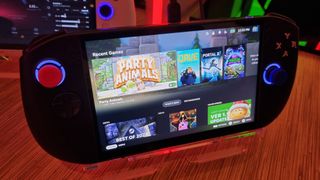It may have been one of the worst kept secrets in gaming hardware, but Lenovo's new Legion Go S is still real exciting. That's not only because this plucky handheld gaming PC packs one of AMD's new Z2 Series processors but also because it's available with SteamOS installed.
The Legion Go S and Legion Go S - Powered by SteamOS (that's the name) are two versions of the same 8-inch handheld gaming PC. Both have been announced over at Lenovo's event at CES 2025.
They're both available with one of AMD's Z2 Series Go processors, which were announced yesterday. There's also a Z1 Extreme option, and both have a slightly larger 55.5 Wh battery than the original Legion Go.
SteamOS is Valve's own Linux-based operating system for handheld gaming PCs, which has so far only officially resided on the Steam Deck. It has been port-able to other devices, but no one has officially taken on the OS for their own device. Until now, anyways.
I got a chance to have a quick play with the Lenovo Legion Go S at the event, and yep, that's a handheld alright. It's slightly reminiscent of the original Asus ROG Ally (albeit a bit more curved and refined) but one thing that jumped out was the performance. I had a quick run through the opening stages of Forza Horizon 5, a game I remember being a little stutter-prone and frame-y on various other handheld gaming PCs I've tried it on.

Not so here. Of course, many updates have passed since I last played it, so perhaps the odd stutter and frame drop has been patched out, but it was a remarkably smooth experience—and may speak well of the potential performance of the Z2 APU in the Glacier White model I was testing.
Overall it's a solid-feeling device, although pesky journos before me had broken a trigger of one of the demo units. I wouldn't take that to mean much though, as we tech journalists are known for being heavy-handed—and we're likely being shown prototypes that aren't quite up to the full release spec.
I made sure to test out the triggers on a couple of other models, and they felt just peachy to me. The chassis is perhaps a little plastic-y, but all the important buttons and controls felt nicely responsive under my hammering thumbs.
The display's a good'un, too, being an eight inch WQXGA 1200p LCD with a 120 Hz refresh rate. It looked nicely vibrant, even when surrounded with the glowing neon lights of the display area, so hopefully that translates to lovely colour reproduction under normal lighting.
So then, a properly interesting addition to the handheld market from Lenovo. I'll be curious to see if my perceived performance impressions match up to the benchmarks, but this is definitely a handheld to keep an eye on when the SteamOS version launches for $500 in May of this year.

 1 week ago
8
1 week ago
8







:quality(85):upscale()/2025/01/14/931/n/1922564/0dc333a96786d52b2c80c7.95468346_.jpg)

 English (US) ·
English (US) ·